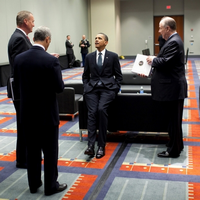In recent weeks, the members of the Obama administration have developed a comprehensive strategy for the Eighth Review Conference of the Nuclear Non-Proliferation Treaty (NPT), which began yesterday. The administration's declared position is to use the conference and other opportunities to strengthen all three of the treaty's core objectives or "pillars": disarmament, nonproliferation, and peaceful uses of nuclear energy. U.S. officials have stressed their support for the fundamental trilateral bargain behind the NPT: Countries with nuclear weapons will move towards eliminating them; states without nuclear weapons will not seek to obtain them; and all countries will enjoy access to peaceful nuclear energy under appropriate safeguards.
The perception that the United States was focusing exclusively on countering nuclear proliferation while neglecting disarmament and nuclear energy contributed to the collapse of the previous NPT Review Conference in 2005. The U.S. delegation to this month's conference, led by Secretary of State Hillary Clinton, therefore is aiming to demonstrate that the United States has made progress in meeting its commitments to reduce the size and role of nuclear weapons in U.S. national security strategy. It also is reaffirming support for the right of countries to pursue peaceful nuclear technologies.
Clinton made several announcements yesterday toward this end. She declared that the administration would support two additional nuclear-weapon-free zones, which would prevent the United States from deploying nuclear weapons in their areas of coverage. She also stated that the United States would increase its financial support to developing countries seeking to use nuclear technologies for civilian energy and humanitarian purposes by providing $50 million to jumpstart a new "IAEA Peaceful Uses Initiative." Most importantly, Clinton announced that the administration is making the U.S. nuclear stockpile more transparent (.pdf) by revealing for the first time the precise number of weapons: 5,113 as of Sept. 30, 2009. In addition to highlighting the administration's commitment to nuclear transparency, the initiative details the dramatic reductions in U.S. nuclear weapons since the Cold War, which has often been overlooked.

